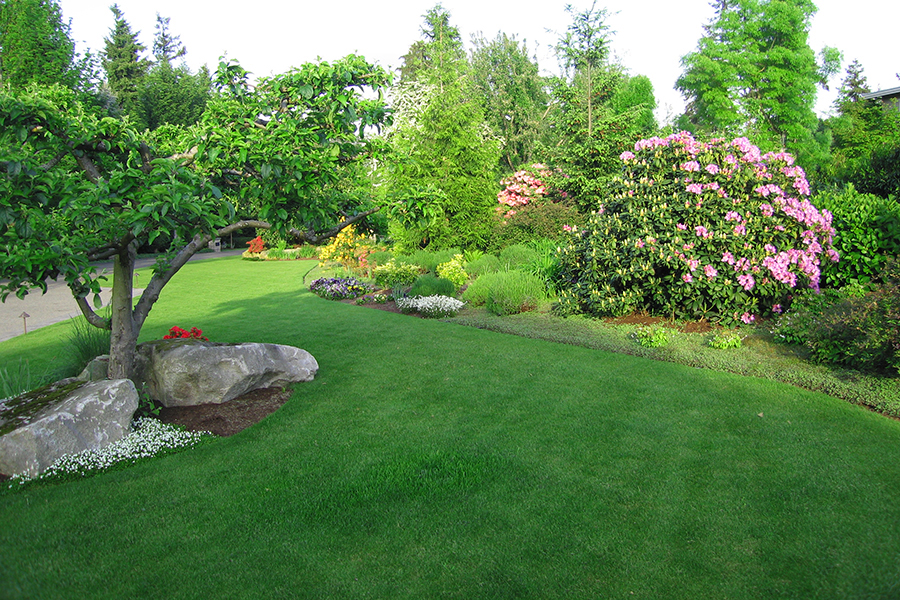Lawns Are Green — But Are They Organic?
If you look out at a field of uncut grass swaying easily in a trickle of wind, fluttering quietly by itself with perhaps a deer or two grazing nearby, you will be watching the planet in its unhurried glory. This is organic the way it is supposed to be. That means carbon-based life forms without a hint of human anxiety about it.
You might say, this is a good starting point. If you now look out at your backyard, you won’t be able to count on one hand mankind’s well-intended interventions. The lawn is cut, more than likely with the help of petrochemicals. The lawn is fertilized, a potentially disrupting cheat on mother nature that included a factory hard at work to produce the fertilizer and an assortment of vehicles used to get it sprinkled on your lawn.
There’s probably a layer of poison out here – if not several. There might be an herbicide targeting weeds and an insecticide targeting bugs. There could be a fence forged from steel, meaning your simple backyard is in cahoots with mining and steel mill industries. There is potentially some plastic out there intentionally or otherwise, which is another nod to petrochemicals and the miracle of our beloved highway system that brought you the product in the first place.
Is there a drainage system under the soil? Just a patch of grass and now you have a bulldozer to thank, as well as the plastic tiling industry that helped get unwanted water off your lawn – goodbye irritating puddles and soft sod.
Maybe a wind blower has helped clear leaves away. Maybe a weed whacker has helped provide the clean finishing touches. And now you have a beautiful, antiseptic back yard, as pretty as a poem.
So imagine my surprise late one night when I heard a public service announcement years ago that urged homeowners to leave the edges of their lawns uncut, allowing for a hiding place for birds, bugs, field mice, moles and squirrels. Leave a foot uncut around the perimeter and you could be feeding any number of local owls. That’s a very quick step towards organic, as I define it.
But this anecdote quickly illustrates that creating a green or an organic lawn on your property is much more about a clear commitment than it is about a specific strategy. Are you in a wealthy neighborhood where leaving grass uncut would shock the neighborhood? Are you in a city where leaving a lawn uncut would provoke local authorities to write you up?
It’s your call.
Here are some Earth-friendly practices you might enjoy.
Create a compost pile.
This takes green matter (lawn clippings, dinner scraps minus the meat) soil and manure. If worked correctly, this process heats up the green matter in a very microbe-friendly environment and accelerates the creation of fresh, dark, loamy soil. Frankly making soil is about as organic and planet friendly as it gets. Ever.
Use a push mower
A push mower provides how many Earth-friendly advantages? They are quiet. They provide exercise. They provide for a slower, more meditative journey through the travails of your backyard. They do not pollute. They are ridiculously easy to maintain. A friend of mine used one for about 75 years or so, dying recently in his late 80s. He always cut his lawn while wearing a knapsack full of tools, so he wasn’t wasting the chance for a workout.
Use local stone instead of concrete
If you have to build a path or a wall, try good old fashioned field stone. This can be beyond gorgeous or rough around the edges. Organic is not as easy to control as man-made materials. Oops. Live with it.
Mulch your leaves in the fall
The best place for your leaves is in the compost pile. Then, nutrients you are taking away go right back where they came from. However, you can also keep the nutrients in place by turning leaves into mulch. This discourages weeds and supports the annual cycle of plants thriving and slowing down.
Yes, your yard will require nitrogen-rich soil as you work each year to deprive it of the natural cycle by removing leaves and lawn clippings, rather than letting them rot in place. But will you take that valuable loam from the compost and just sprinkle it on the lawn? Probably not – but it wouldn’t hurt if you did and now you know the score.Take away leaves and grass clippings and lawns will eventually require fertilizer to keep them green. Leave clippings and leaves in place and they can thrive without that intervention.
Use plantings to support the local food chain
Specific plantings can be made to attract your favorite bird, mammal, or bug. Care for a few butterfly? Many use milkweed to bring them in. You can target specific songbirds with thistle and deer with salt licks. A well placed stone in a sunny spot can encourage snakes to move in. Bird baths and feeders are valuable as well.
Plant with the canopy in mind
Besides planting flowers to admire, think about how you might landscape vertically. Flowers down low, bushes for the middle heights and trees for the taller heights. Then, keep in mind that various trees are important food sources. Nut trees support rodents, while fruit trees support birds (and people).
Herbs and veggies!
That’s right, growing herbs and veggies is a terrific gesture on behalf of Mother Nature. Not only do you have smaller food bills, you have fresher, healthier food. In theory, you have also cut back on the great collective energy drain, which is to say less trucking to bring produce to stores and less energy used by grocers to keep vegetables cool and fresh.



